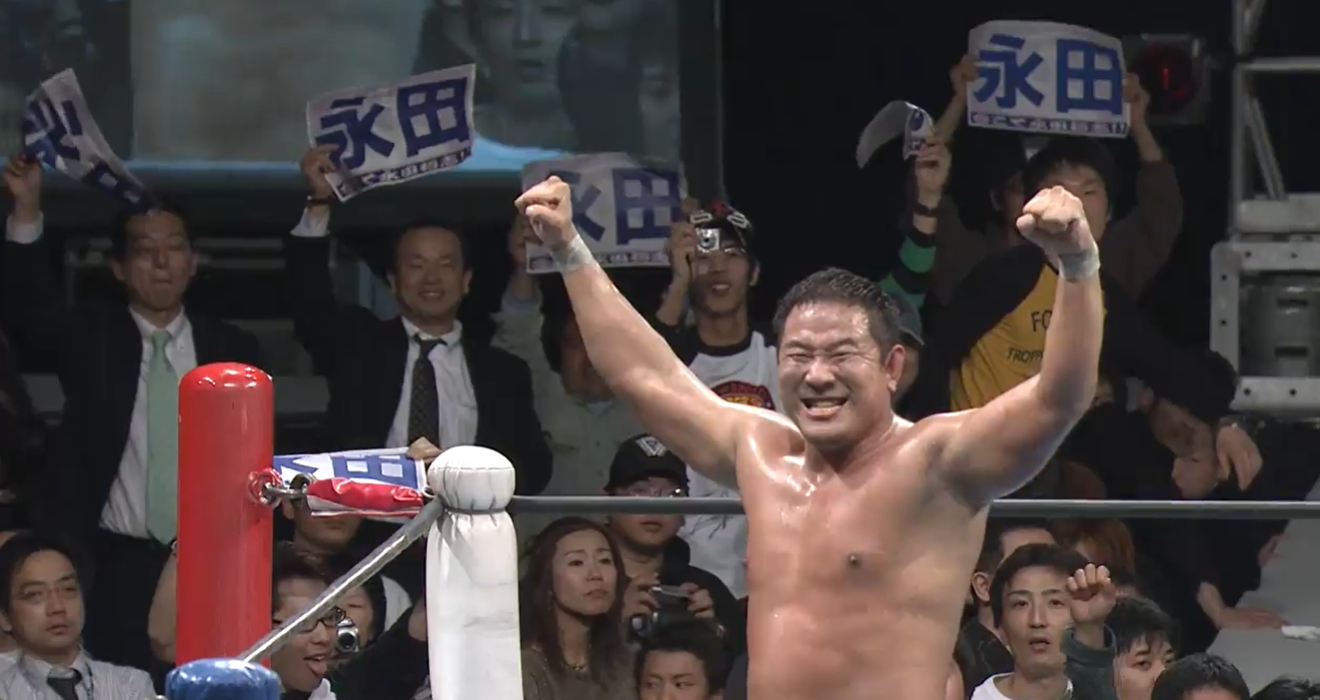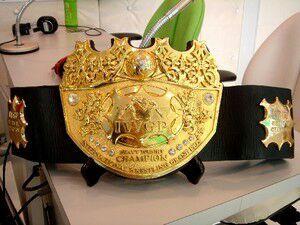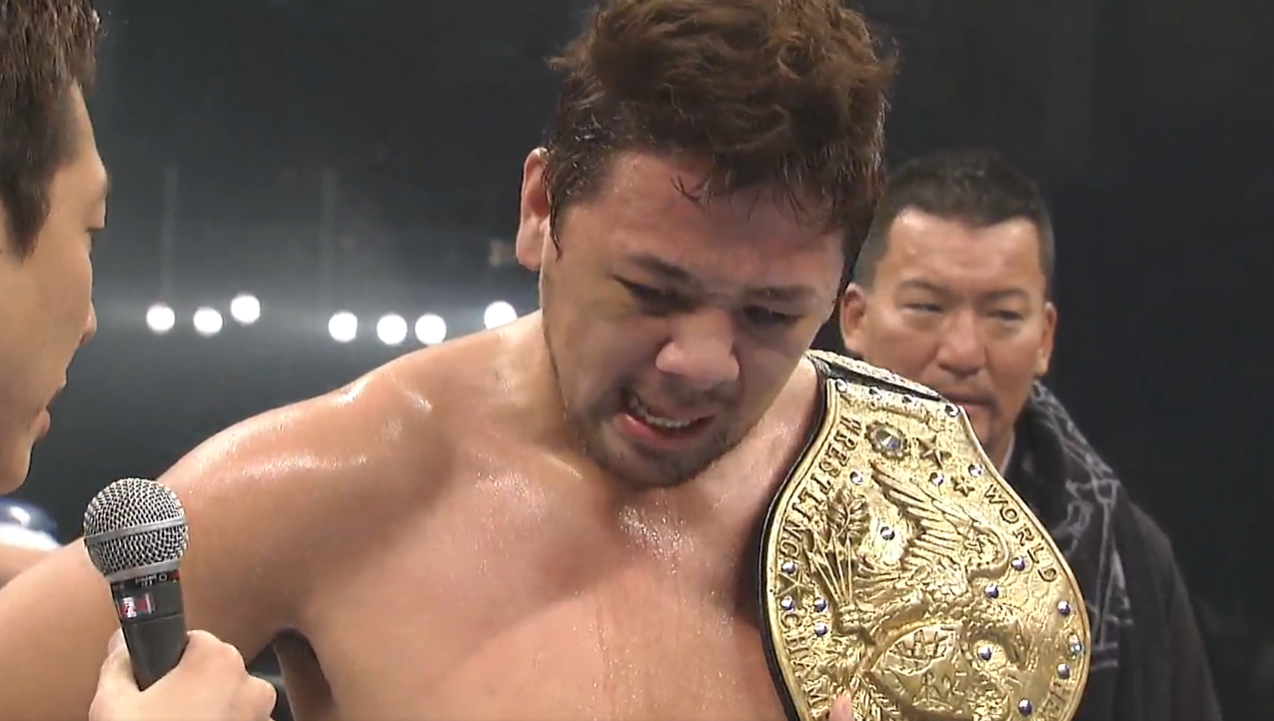Tadao Yasuda’s first and only reign as IWGP Heavyweight Champion lasted a mere 48 days. On April 5th, 2002, he lost the title to someone who actually deserved to hold it.
Someone who was actually skilled as a pro wrestler, stemming from his NJPW training and origins as an amateur wrestler: Yuji Nagata. This is part 3 of the History of the IWGP Heavyweight Championship.
Nagata’s reign provided a brief reprieve from NJPW owner Antonio Inoki’s obsession with MMA. At last, the biggest draw in New Japan Pro Wrestling was an actual pro wrestler through and through.
But Nagata more than had his hands full. Basically, he had to Bret Hart his way forward. Carrying an entire wrestling promotion on his back. This began an era of struggle, desperation, and attempted recovery.
It was a period during which Nagata and other established NJPW pro wrestlers had to drag the company through the mud to try and save the ailing promotion.

History of the IWGP Heavyweight Championship – Pary 3 –
The Struggle for Success
Nagata went into his reign hoping to undo some intense problems that had plagued him beforehand.
On December 31st, 2001, Nagata was booked to fight (not wrestle, fight) Mirko Cro Cop in a wrestler-versus-MMA-fighter match. Mirko destroyed Nagata in 21 seconds, which severely tarnished Nagata’s reputation.
Secondly, three months prior to his IWGP Heavyweight title win, Nagata experienced a rather embarrassing loss.
At the January 4 Dome show in 2002, Nagata faced Pro Wrestling NOAH’s then-GHC Heavyweight Champion Jun Akiyama in the main event.
It was a good match, especially considering how similar the two men were in styles and in their choices of moves. But it was Akiyama that won.
A NOAH wrestler beat an NJPW wrestler clean. On NJPW’s biggest annual event. It seemed like a questionable decision to some, but Nagata was still the NJPW’s chosen star to carry their brand going at the time.
Nagata’s first reign as IWGP Heavyweight Champion was a mild success for NJPW. He brought prestige back to the title as champion and carried the brand on his shoulders.
He did this by defending the belt ten times, which was a new record at the time for title defenses during a single championship run.
Fans started to care about the NJPW brand a bit more, especially as Nagata’s reign lasted 392 days, making it one of the longest ever.
This reign included some notable defenses, including one against fighter Josh Barnett. Nagata defeated Barnett in the main event of the 2003 January 4 Dome Show.
The Yoshihiro Takayama Choice
But all good things must come to an end and NJPW needed the right person to end Nagata’s reign. Luckily, they made the right choice: Yoshihiro Takayama.
The monstrous Takayama was, at the time, the biggest combat sports star in Japan. He became world-famous following his legendary brawl with Don Frye at PRIDE 21.
Following that epic fight, Takayama became something of a crossover superstar. He was a trained pro wrestler, and though he failed at MMA, he proved he had the toughness to survive in that sport without getting destroyed in seconds.
And so, on May 2nd, 2003, Takayama ended Nagata’s reign and became IWGP Heavyweight Champion. In doing so, he also became a dual world champion because he also held an older title, the NWF Heavyweight Championship, at the same time.
History of the IWGP Heavyweight Championship – Part 3
Where to go from there?
But from there, NJPW found themselves in trouble once again. They needed someone new to carry the crown going forward. They couldn’t rely on Takayama long term.
He was a freelancer and had started working with rival company Pro Wrestling NOAH more and more. And they couldn’t put the belt on Nagata again.
He had been overtaxed during his first reign and Inoki was grooming him for another Inokism-inspired crossover fight. (Nagata would also get destroyed by Fedor Emilianenko in just over one minute in December 2003).
Thus, NJPW’s bookers surveyed the landscape and found two promising wrestlers: Hiroshi Tanahashi and Shinsuke Nakamura. Now, these were not the same two wrestlers that most modern fans know and love. Back in 2002 and 2003, Tanahashi and Nakamura weren’t the high-flying ace and the King of Strong Style. Tanahashi was still a fairly generic rookie with some decent grappling skills. But hadn’t yet mastered his style or his identity as a performer. Nakamura, meanwhile, had arguably the blandest gimmick in the world: that of an angry MMA fighter.
History of the IWGP Heavyweight Championship – Part 3
The Rise of the King of Strong Style
Given Nakamura’s persona and youth, NJPW’s bookers decided to make him into their next big star. Dubbed ‘the super rookie,’ Nakamura was soon catapulted into the main event scene in NJPW.
On December 9th, 2003, Nakamura defeated transitional champion Hiroyoshi Tenzan to become the youngest IWGP Heavyweight Champion ever, at only 23 years old.
And to prove how much faith Inoki had in Nakamura, Nakamura defeated Takayama on the January 4th, 2004, Dome Show. Unifying his IWGP title with Takayama’s NWF Heavyweight title.
Pushing Nakamura this hard this fast was a questionable decision for many. Nakamura had only around one year’s worth of wrestling experience, and Tenzan was considered the most popular wrestler on NJPW’s roster.
But it wasn’t just Nakamura’s win that had marked a troubling time for New Japan. It was his predecessor, Tenzan, that started a trend that brought NJPW down to its absolute pits.
The Darkest Days
Nagata’s first reign lasted 392 days and brought prestige back to the IWGP Heavyweight Championship. But the 676-day period between November 3rd, 2003, and July 18th, 2005 undid all of Nagata’s work and did even more damage on top of that.
This was a period that was reminiscent of 1999’s WWF/E. Where the title changed hands so frequently that it felt less like a prestigious title. And more like a prop in a cheap vaudevillian theatre show.
During this period, the title changed hands thirteen times, including two times it was vacated. Nakamura held the title for 58 days before vacating it due to injuries. A tournament was held to crown a new champion, which Tenzan won.
But his reign only lasted 26 days as he lost the title to Kensuke Sasaki on March 12th, 2004. And Sasaki’s reign was the shortest title reign ever, lasting only 16 days. And the man Sasaki lost it to was Bob Sapp.
Yes, that Bob Sapp.
Bob Sapp’s reign as IWGP Heavyweight Champion reeked of desperation to many people. On one hand, Sapp was incredibly popular in Japan as an athlete, owing to his fighting prowess in PRIDE Fighting Championships and K-1.
But he was not a pro wrestler at all. He had little to no knowledge of how to put on a proper wrestling match. And as such, his in-ring abilities were incredibly limited.
In a twisted sort of way, this was the Japanese version of David Arquette winning the WCW World Championship. The difference being was that Sapp was a successful fighter in a more legitimate combat sport while Arquette was a successful actor.
In both cases, a non-wrestler won a wrestling heavyweight championship, making countless fans groan in unison.
As if his reign wasn’t bad enough, the manner in which he lost it was even worse. Sapp never lost the title in a match. Instead, NJPW stripped him of the title after he lost a shoot fight (i.e. real fight) against Kazuyuki Fujita in K-1.
In other words, NJPW felt that their champion shouldn’t lose in a real fight (which is something he can’t really control), and thus punished him for his inability to win in a real fight.
On one hand, it took the belt away from someone that shouldn’t have had any business winning it in the first place. On the other hand, it felt like a huge cop-out for Sapp and seemed like a very silly way to change the title.
The Kazuyuki Fujita Reign
To add more salt in the wound, it would be Fujita that would win the IWGP Heavyweight Championship, with Sapp’s reign ending at 66 days. And the man Fujita beat to win the vacant title? Rising star Hiroshi Tanahashi.
Fujita’s reign was longer than expected, lasting 126 days with only one successful title defense. He lost the belt to Sasaki, but the manner in which he lost was rather, well, pathetic.
Fujita had Sasaki locked in a sleeper submission hold, but his shoulders were on the mat. All Sasaki had to do was position himself into a position in which he’s on top of Fujita to pin him (an easy thing for Sasaki to do given how strong he was).
In doing so, Fujita screwed himself out of the title, causing the belt to change hands yet again, much to fans’ chagrin.
Kazuyuki Fujita dominates and humbles IWGP Heavyweight Champion Bob "The Beast" Sapp at K-1 MMA ROMANEX,May 22,2004,Saitama,Japan.Fujita made Sapp tap out at 2:15 in the first round.Sapp would vacate the IWGP Title not long after and Fujita would win the title in a tournament pic.twitter.com/wU0LW5VY5l
— Rasslin' History 101 (@WrestlingIsKing) January 12, 2019
The 2004 calendar year did end on a somewhat happy note as it was fan favorite Tenzan that beat Sasaki to win the title for the third time. But Tenzan wasn’t able to make any successful defenses, and certainly not on the annual January 4 Dome Show.
Not because he didn’t want to or because of injury. But because NJPW didn’t think it was important enough to defend that year. The 2005 Dome Show was centered on a one-night submission-only tournament featuring – you guessed it – mixed martial artists.
The only titles defended on that show were the Junior Heavyweight title and Tanahashi’s U-30 Championship (which would be deactivated about a year later anyway).
Tenzan did wrestle on this show, but it was in a meaningless Triple Threat match with no title on the line.
History of the IWGP Heavyweight Championship – Part 3
An improvement for the title?
Things did improve slightly for the title (but not for Tenzan) with its next holder. On February 20th, 2005, Tenzan lost the title to former tag partner and then-AJPW Triple Crown Heavyweight Champion Satoshi Kojima.
Kojima had left NJPW to AJPW with Keiji Mutoh in 2002 and had flourished in that promotion thanks to his hard-hitting style and more traditional pro wrestling presentation.
That match had a unique finish that was designed to look like a ‘shoot’. The bookers capitalized on Tenzan’s real-life injuries and booked the match to make it look like he couldn’t continue with only seconds before the match would’ve ended in a 60-minute draw.
Thus, Kojima became the first person to hold the heavyweight titles in both NJPW and AJPW at the same time. He held NJPW’s title for 83 days before losing it back to Tenzan, who, in turn, lost it to Fujita 65 days later.
That marked the last time Tenzan would hold the IWGP Heavyweight Championship. His final record totals four reigns and two successful defenses, with a total length of 197 days.
But things weren’t that rosy for Fujita either because NJPW had signed a big star for him to wrestle for the title. One that would make headlines for NJPW, and (in hindsight) not in a good way: Brock Lesnar.
The Beast in The East
Brock Lesnar came to Japan after his attempts at a football career floundered. He was the biggest foreign star NJPW could’ve possibly signed. This was shown through his booking.
In his first NJPW match, Lesnar won the IWGP Heavyweight Championship in a triple-threat match between Fujita and Masahiro Chono.
Chono, you might recall, was the only one of the original Three Musketeers of New Japan left in New Japan.
He had become less involved with NJPW since the Inokism experiment started, and his loyalty was rewarded with him – not Fujita – being the one to eat a pin from Lesnar.
Lesnar’s reign ended up being more successful than the previous four champions combined.
His lasted 280 days and three successful defenses: one against Nakamura in the Tokyo Dome, one against sumo champion Akebono (that same one of WrestleMania 21 fame), and one against Giant Bernard.
But the reign was not without its controversies. Throughout his run in NJPW, WWE kept filing injunctions and lawsuits to try and stop Lesnar from wrestling there. These lawsuits all failed and Lesnar continued wrestling for NJPW…until June 15th, 2006.
On that day, Brock Lesnar was stripped of the IWGP Heavyweight Championship. Initial reasons for this were unclear but the general rumor was that Lesnar wouldn’t defend it in Japan due to ‘visa issues’. But the problem with this was that Lesnar still held the physical belt and wouldn’t return it.
After all, who in their right mind would approach Brock Lesnar and demand he returns something if he didn’t want to? What man wanted to have the unfortunate task of warning Lesnar or threatening him if he didn’t comply? Whoever it was, they didn’t succeed because Lesnar wouldn’t return the belt until a year later.
History of the IWGP Heavyweight Championship – Part 3
A Tale of Two Belts
The period of June 2006 to June 2007 was notable because it featured two IWGP Heavyweight Championship belts. Brock Lesnar held one and refused to return it.
In response, NJPW held a tournament that was won by Hiroshi Tanahashi. Tanahashi was given a new belt, the third belt, which has been the same belt design used to date.

As for Lesnar, he did eventually defend his belt…in another company. In late 2005, Antonio Inoki, founder of NJPW, was forced out of his own company.
Yukes, the video game company that made some of the earlier (read: best) WWE video games purchased his majority share an outed him from New Japan. It seemed they were tired of his MMA shenanigans, too.
Inoki Genome Federation
In response, Inoki created his own new promotion, Inoki Genome Federation (IGF). He did so with Lesnar as its recognized and ‘true’ IWHP Heavyweight Champion. Lesnar held this belt until June 29th, 2007, when he lost it to Kurt Angle.
Meanwhile, in New Japan, Tanahashi’s first reign was the first sign of potential change. He didn’t go through multiple, short title reigns.
His first reign was almost as long as Lesnar’s, lasting 270 days and four title defenses. He lost the title to Yuji Nagata in April 2007.
But this was all part of the master plan. Tanahashi had been chosen to become the new ace, and thus a slow, methodical story began to unfold. True, he held the belt but wasn’t considered top of the company just yet.
He needed to prove himself to the audience first. And so he lost to a company mainstay and highly-skilled grappler in Nagata but regained the title 88 days later.
History of the IWGP Heavyweight Championship – Part 3
A Light at the end of the Tunnel
Then, Tanahashi’s next big matchup would act as the nail in the coffin for NJPW’s darkest period. On January 4th, 2008 at Wrestle Kingdom II, Tanahashi defended the IWGP Heavyweight Championship against Shinsuke Nakamura and lost.
Then, a month later, Nakamura defeated Kurt Angle to unify his IWGP Heavyweight Championship with the IGF-version that had once been held by Lesnar.
In a way, Nakamura ended up having the last laugh. Lesnar beat Nakamura in his first title defense two years earlier at the 2006 Dome Show, despite all logical booking suggesting the opposite take place.
Now, Nakamura held NJPW’s biggest prize and stood tall while Lesnar left pro wrestling altogether.

But NJPW wasn’t completely out of the woods yet. Things were still difficult for pro wrestling in general, especially with the company not having a clear, unifying ace.
Luckily, things would soon be looking up for the company as they made some key decisions that ended up saving them from the brink of disaster.










